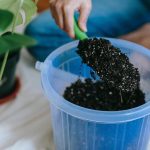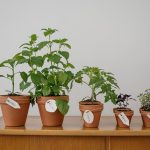If you're considering the cultivation of plants, ponder the practicality of fabric pots. These flexible containers offer perks like enhanced aeration and root development, making them a popular choice among gardening enthusiasts.
But before you fully embrace these pots, it's crucial to weigh their advantages and drawbacks. From improved drainage to potential water retention issues, fabric pots come with both boons and banes.
So, let's delve into the pros and cons to make an informed decision for your gardening endeavors.
Key Takeaways
- Improved growth and development of plants
- Enhanced aeration and drainage
- Stimulates root branching and healthier root systems
- Cost-effective and durable for multiple growing seasons
Benefits of Fabric Pots
Fabric pots offer numerous advantages for growing healthy plants in your garden. When it comes to improved growth, fabric pots have a clear edge over traditional plastic or ceramic containers. The porous fabric allows for better aeration and drainage, preventing issues like waterlogged soil and root rot. This aeration also promotes air pruning, which stimulates root branching and ultimately leads to healthier, more robust root systems. As a result, plants grown in fabric pots often exhibit accelerated growth and overall better development compared to those in traditional pots.
In addition to improved growth, fabric pots also stand out for their cost effectiveness. While the initial investment may be slightly higher than traditional pots, the durability of fabric pots ensures that they can be used for multiple growing seasons. Their ability to withstand harsh weather conditions and resist deterioration means that you won't need to replace them frequently, making them a more economical choice in the long run. This cost effectiveness is further enhanced by the fact that fabric pots can be easily cleaned and stored, adding to their value and longevity.
Improved Root Aeration
When using fabric pots, the improved root aeration allows for enhanced oxygen exchange, ensuring that your plants receive the necessary oxygen to thrive.
This increased aeration also facilitates better nutrient absorption, promoting healthier and more robust plant growth.
Additionally, fabric pots reduce the risk of root rot by preventing waterlogging and promoting optimal soil drainage.
Enhanced Oxygen Exchange
You'll experience improved root aeration with fabric pots, allowing for better oxygen exchange compared to traditional containers. Enhanced oxygen exchange is crucial for maintaining optimal root health and overall plant growth. Here's how fabric pots facilitate this process:
- Fabric pots prevent root circling, promoting healthier root structures.
- The permeable fabric allows air to penetrate the pot, preventing the root system from becoming waterlogged.
- Increased oxygen levels in the root zone enhance nutrient uptake and overall plant vigor.
- Fabric pots also provide insulation, preventing the roots from overheating in hot weather.
These factors work in tandem to create an environment that fosters enhanced oxygen exchange, ultimately leading to improved root aeration and healthier, more robust plants.
Better Nutrient Absorption
To improve nutrient absorption, fabric pots enhance root aeration, allowing for better oxygen exchange and nutrient uptake in your plants. This improved root aeration leads to enhanced growth and increased yields.
With fabric pots, the root system can access more oxygen, which is essential for nutrient absorption and overall plant health. The enhanced aeration promotes healthy root development, resulting in stronger and more efficient nutrient uptake.
As a result, your plants can utilize nutrients more effectively, leading to improved growth and increased yields. Additionally, fabric pots contribute to water efficiency, as the enhanced root aeration allows for better water drainage and prevents waterlogging, ultimately supporting the optimal nutrient absorption and growth of your plants.
Reduced Risk of Rot
Fabric pots promote improved root aeration, reducing the risk of rot and supporting healthier plant growth. This is achieved through enhanced moisture management and optimal air circulation, which are crucial for maintaining plant health.
With fabric pots, you can expect:
- Enhanced moisture management: Fabric pots allow excess water to drain out easily, preventing waterlogging and reducing the risk of root rot.
- Improved root aeration: The breathable fabric of the pots facilitates better air circulation, preventing the roots from suffocating and promoting overall plant health.
- Reduced risk of overwatering: The breathable nature of fabric pots helps to prevent water from being trapped around the roots, reducing the likelihood of overwatering and associated fungal issues.
- Healthier root system: By reducing the risk of rot, fabric pots support the development of a healthier and more robust root system, leading to better nutrient absorption and overall plant vitality.
Enhanced Drainage and Air Pruning
Enhanced drainage and air pruning are key benefits of using fabric pots for your plants, promoting healthier root systems. The fabric material of these pots allows for improved water retention while preventing overwatering, which can lead to root rot in traditional plastic pots. The enhanced drainage in fabric pots ensures that excess water can easily escape, preventing waterlogged soil and root suffocation. This helps to create an optimal environment for root development, allowing for the growth of a robust and well-established root system.
Moreover, the fabric material of these pots promotes air pruning, a process in which the plant's roots are naturally pruned as they come into contact with the air outside the pot. This pruning encourages the roots to branch out and grow more fibrous, which ultimately leads to a healthier and more extensive root system. The increased aeration and oxygen flow to the roots also contribute to better nutrient uptake and overall plant health.
Portability and Storage
Fabric pots' portability and storage capabilities make them a convenient choice for avid gardeners.
When it comes to portability benefits, fabric pots are lightweight and easy to move around, allowing you to rearrange your garden or bring plants indoors during extreme weather. Their flexibility also makes them ideal for those who may need to transport their plants frequently, such as renters or those participating in gardening events.
Additionally, fabric pots can be easily folded or collapsed when not in use, making them a great option for gardeners with limited storage space. They can be stacked neatly, stored in small spaces, or hung on hooks when empty, providing practical storage solutions for urban or indoor gardeners.
Furthermore, the breathable nature of fabric pots allows for air circulation even when stacked, reducing the risk of mold and mildew formation compared to traditional pots.
Potential Water Retention Issues
One drawback to consider with fabric pots is that they may retain excess water, potentially leading to overwatering issues if not managed carefully. Fabric pots, while excellent for promoting air pruning and preventing root circling, can also pose challenges in regulating soil moisture. The porous nature of fabric allows for aeration and drainage, but it also means that they can hold onto more water than traditional pots. This can be advantageous in arid climates or for plants that thrive in consistently moist soil. However, for plants that are sensitive to overwatering, such as succulents or herbs, fabric pots require attentive monitoring.
| Pros | Cons |
|---|---|
| Promotes air pruning | Retains excess water |
| Prevents root circling | Requires careful moisture management |
| Aids in aeration and drainage | May lead to overwatering issues if not monitored |
To mitigate potential water retention issues, it's crucial to select the appropriate soil mix and establish a proper watering routine. Monitoring soil moisture levels and adjusting watering frequency accordingly is key to maintaining optimal conditions for plant growth while utilizing fabric pots.
Environmental Impact and Sustainability
An important aspect to consider when evaluating fabric pots is their environmental impact and sustainability. Fabric pots offer several environmental benefits, making them a sustainable choice for gardening.
- Biodegradability: Fabric pots are often made from biodegradable materials, reducing their environmental impact at the end of their lifespan.
- Air Pruning: The porous nature of fabric pots promotes air pruning, which encourages healthier root systems and reduces the need for plastic containers that may take centuries to decompose.
- Water Conservation: Fabric pots allow for better water drainage and aeration, which can lead to more efficient water usage and reduce the overall environmental impact of gardening.
- Reduced Waste: Many fabric pots are reusable, reducing the amount of waste generated from single-use plastic containers commonly used in gardening.
Considering these factors, fabric pots align with the principles of sustainable gardening and environmental impact assessment. By choosing fabric pots, you not only contribute to sustainable gardening practices but also minimize the environmental footprint of your gardening activities.
Considerations for Long-Term Durability
When considering the long-term durability of fabric pots, assess the quality of the material and its ability to withstand environmental factors. Material composition plays a crucial role in determining the longevity of fabric pots. Look for pots made from durable, high-quality fabric such as thick, UV-resistant polyethylene or geotextile material, as these are known for their longevity and ability to resist wear and tear. Fabrics with reinforced stitching and sturdy handles also contribute to long-term durability, ensuring that the pots can withstand the weight of soil and plants without falling apart.
Additionally, consider the weather resistance of fabric pots. Look for pots that can withstand a wide range of environmental conditions, including extreme heat, cold, and moisture. Pots with good weather resistance are less likely to degrade over time, ensuring their long-term usability. Assess the fabric's ability to resist fading, tearing, and mold growth, as these factors can significantly impact the pots' durability.
Frequently Asked Questions
Are Fabric Pots Suitable for All Types of Plants, Including Those With Extensive Root Systems?
Yes, fabric pots are suitable for all types of plants, including those with extensive root systems. They promote healthy root development, provide excellent water retention, aeration, and drainage. This makes them ideal for supporting the growth of various plants.
How Do Fabric Pots Compare to Traditional Plastic Pots in Terms of Cost and Lifespan?
When comparing fabric pots to traditional plastic pots, fabric pots generally cost more initially but offer better durability and lifespan. The upfront investment may be higher, but the long-term benefits make them a worthwhile choice.
Can Fabric Pots Be Used in Both Indoor and Outdoor Gardening Settings?
Fabric pots are versatile for indoor and outdoor gardening, providing benefits like better aeration and temperature control. However, they may limit root system growth due to their breathable material, so consider this for certain plants.
What Are the Best Practices for Cleaning and Maintaining Fabric Pots to Prevent Mold and Mildew Growth?
To prevent mold and mildew growth, clean and maintain fabric pots regularly. Use a mild soap and water solution to clean the pots, ensure good drainage, and monitor watering frequency to keep soil from becoming waterlogged.
Are There Any Specific Soil or Watering Requirements When Using Fabric Pots?
When using fabric pots, consider soil composition and watering frequency. Use well-draining soil for optimal growth and water more frequently than traditional pots. Fabric pots allow better aeration, so adjust watering to prevent soil from drying out too quickly.
- Dyeing Faux Suede Fabric: Tips for Success - July 12, 2025
- How to Clean Suede Furniture Fabric at Home - July 12, 2025
- The Best Methods for Cleaning Faux Suede Upholstery - July 12, 2025







